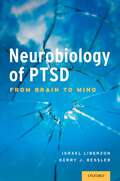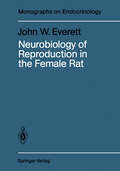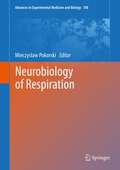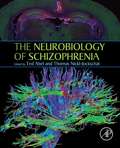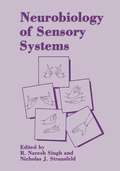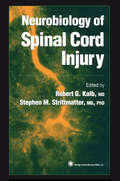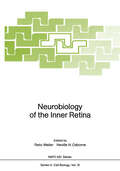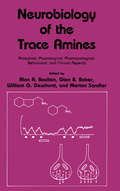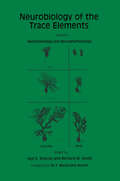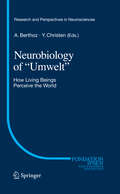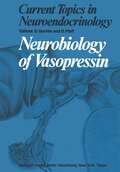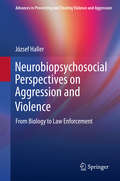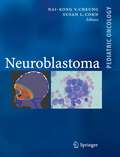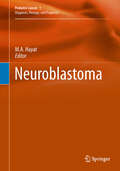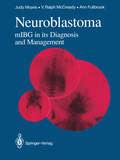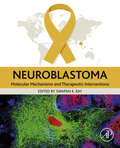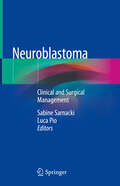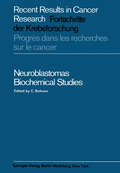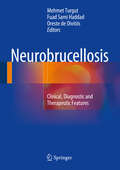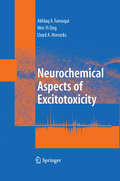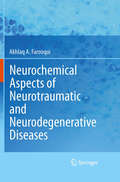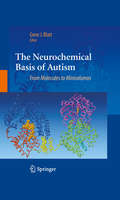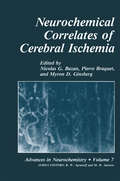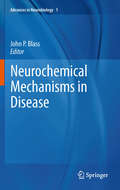- Table View
- List View
Neurobiology of PTSD: From Brain to Mind
by Israel Liberzon and Kerry J. ResslerNeurobiology of PTSD outlines the basic neural mechanisms that mediate complex responses and adaptations to psychological trauma, describing how these biological processes are impaired in individuals with posttraumatic stress disorder (PTSD). Throughout three comprehensive sections, expert authors present detailed analysis of the neural circuitry of emotion, biological findings in post-traumatic stress disorder, and neuroscience informed treatment and prevention. This book is a foundational resource for psychiatrists, neuroscientists, psychologists, and allied health professionals.
Neurobiology of PTSD: From Brain to Mind
Neurobiology of PTSD outlines the basic neural mechanisms that mediate complex responses and adaptations to psychological trauma, describing how these biological processes are impaired in individuals with posttraumatic stress disorder (PTSD). Throughout three comprehensive sections, expert authors present detailed analysis of the neural circuitry of emotion, biological findings in post-traumatic stress disorder, and neuroscience informed treatment and prevention. This book is a foundational resource for psychiatrists, neuroscientists, psychologists, and allied health professionals.
Neurobiology of Reproduction in the Female Rat: A Fifty-Year Perspective (Monographs on Endocrinology #32)
by John W. EverettIt has been my privilege and pleasure during the past half century to participate in the unfolding of present-day concepts of the mammalian female reproductive cycles. When the studies recorded here began in the late 1930s it was already established that cyclic ovarian function is governed by gonadotropic secretions from the anterior pituitary gland, the "conductor of the endrocrine orchestra," and that in turn this activity is importantly dependent in some way upon secretion of estro gens and progesterone by the ovaries. Although a role of the nervous system was recognized for the reflex-like induction of ovulation in rabbits and cats and the in duction of pseudopregnancy in rats and mice, and although there was even some evidence of neural participation in ovulation in rats, a major central neural role in the female cycle of most species was not apparent. Gonadotropic fractions of pitui tary extracts having distinct follicle-stimulating and luteinizing activities in test ani mals had been obtained, and these respective effects had been fairly well charac terized. Prolactin was well known for its lactogenic activity, but its luteotropic role in rats and mice had yet to be revealed. The molecular structure of the several estro gens and progesterone was known, and they were readily available as synthetic pro ducts. The broad concept of ovarian-pituitary reciprocity appeared to be an accept able explanation of the female cycle, with the ovary in control through the rhythmic rise and fall in secretion of follicular estrogen.
Neurobiology of Respiration (Advances in Experimental Medicine and Biology #788)
by Mieczyslaw PokorskiRespiration is an area of the medical study that undergoes fast developments. A better understanding of the neural and cellular mechanisms underlying respiratory disorders and lung function is essential for the evidence-based pharmacotherapy and for optimizing the patient care and prophylactic measures to improve the health and quality of life. This comprehensive book is a blend of basic and clinical research. The book is thought to promote the translation of science into clinical practice. The book presents an update on the areas of current research and clinical interest in the neurobiology of the respiratory system. Recent innovations in detection and management of respiratory diseases are described. The book will be a base of reference in the field of respiration for years to come and a source of future research ideas. This book is a required text for respiratory scientists, neuropathologists, and for clinicians searching for ‘bench to bedside’ treatments of lung diseases.
The Neurobiology of Schizophrenia
by Thomas Nickl-Jockschat Ted AbelThe Neurobiology of Schizophrenia begins with an overview of the various facets and levels of schizophrenia pathophysiology, ranging systematically from its genetic basis over changes in neurochemistry and electrophysiology to a systemic neural circuits level. When possible, the editors point out connections between the various systems. The editors also depict methods and research strategies used in the respective field. The individual backgrounds of the two editors promote a synthesis between basic neuroscience and clinical relevance.Provides a comprehensive overview of neurobiological aspects of schizophreniaDiscusses schizophrenia at behavioral, cognitive, clinical, electrophysiological, molecular, and genetic levelsEdited by a translational researcher and a psychiatrist to promote synthesis between basic neuroscience and clinical relevanceElucidates connections between the various systems depicted, when possible
Neurobiology of Sensory Systems
by R. Naresh Singh Nicholas J. StrausfeldThe traveller to India is urged to visit that country's western shore with the Arabian Sea where, about 300 miles to the south of Bombay, an exceedingly lovely coast reaches the peak of its harmony at the erstwhile Portuguese enclave of Goa. The ambience of this alluring province is an exquisite balance of palm trees and rice fields, aged colonial homes -many still elegant and brightly painted -slowly being swallowed up by the exuberant tropical vegetation, incredible blossoms, colorful and courteous people and, deeper inland, some splendid examples of 17th and 18th century Portuguese ecclesiastical architecture. A feast for the eyes by day, and in the evening enough fresh fish and other good food to satisfy the most demanding gourmet. This was the paradisiacal setting for the first International Conference on the Neural Organization of Sensory Systems (ICONOSS for short), sponsored jointly by the International Brain Research Organization (IBRO), the Tata Institute for Fundamental Research at Bombay, the Department of Atomic Energy of the Government of India, and the Department of Science and Technology of the Government of India. About 100 participants were pleasantly confined at Fort Aguada, a resort cunningly built amongst the ruins of an old Portuguese fort. The conference program achieved an international flavor, recruiting scientists from many nations: India (naturally), Australia, Britain, Canada, Germany, Finland, France, Hungary, Japan, the Netherlands, Sweden, Switzerland and the United States of America. The subjects discussed were as diverse as the countries represented.
Neurobiology of Spinal Cord Injury (Contemporary Neuroscience)
by Stephen M. Strittmatter Robert G. KalbDistinguished researchers review the latest scientific understanding of spinal cord injury (SCI), focusing on the mechanisms causing paralysis after spinal cord trauma, the molecular determinants of neural regeneration, and methods for improving damaged function. The authors examine the role of intracellular Ca2+ in neuronal death, the possibility of spinal learning, growth-promoting molecules for regenerating neurons, and the biochemistry and cell biology of microtubules. Among the treatment possibilities discussed are cell transplantation strategies beyond the use of fetal spinal cord tissue, remyelination in spinal cord demyelination models, high steroid therapy immediately after SCI, and the mixed use of anti- and proinflammatories. Comprehensive and highly promising, Neurobiology of Spinal Cord Injury summarizes and integrates the great progress that has been made in understanding and combating the paralysis that follows spinal cord injury.
Neurobiology of the Inner Retina (Nato ASI Subseries H: #31)
by Reto Weiler Neville N. OsborneThe relatively simple, stratified nature of the retina and its spe- fied use in the visual process has long made it an inviting tissue to study both for its own sake and as a model for the more complex processes of the brain. For these dual purposes, the retina can be thought of as basically consisting of two functional pans. First, the outer retina, comprised of the photoreceptor cells and attendant pigment epithelium, serves to capture the photic energy and convert it into a neurochemical response. Second, the inner layers of the retina, mainly bipolar, amacrine and ganglion cells (and their attendant Maller cells), function more clearly as a typical part of the CNS, transmitting the photic signals to the brain. Between the 8th and 12th of August 1988 more than seventy scientists from allover the world gathered in Oldenburg (Federal Republic of Gennany) for a meeting "The neurobiology of the inner retina" which was devoted entirely to the neural mechanism of the inner synaptic layer of the verte brate retina. The meeting comprised twenty - three separate lectures and four specially arranged discussion groups. In addition, a number of posters were displayed and a period was allotted specifically for the discussion of these posters. The articles contained in this book will serve as a record of the papers delivered at the Oldenburg Meeting and illustrate the advances made in trying to understand the importance of the diversity of amacrine cell morphology and physiology in retinal function.
Neurobiology of the Trace Amines: Analytical, Physiological, Pharmacological, Behavioral, and Clinical Aspects (Polymer Science and Technology Series #37)
by Alan A. Boulton Glen B. Baker William G. Dewhurst Merton SandlerNeurobiology of the Trace Elements: Volume 2: Neurotoxicology and Neuropharmacology (Contemporary Neuroscience)
by Ivor E. Dreosti Richard M. SmithF. Macfarlane Burnet I have been an interested onlooker for many years at research on the biology of trace elements, particularly in its bearing on the pas toral and agricultural importance of copper, zinc, cobalt, and mo lybdenum deficiencies in the soil of various parts of Australia. More recently I have developed a rather more specific interest in the role of zinc, particularly in relation to the dominance of zinc metalloenzymes in the processes of DNA replication and repair, and its possible significance for human pathology. One area of special significance is the striking effect of zinc deficiency in the mother in producing congenital abnormalities in the fetus. The fact that several chapters in the present work are concerned with this and other aspects of zinc deficiency is, I fancy, the editors jus tification for inviting me to write this foreword. In reading several of the chpaters before publication, my main impression was of the great potential importance of the topic of trace metal biology in both its negative and positive aspects-the effects of deficiency of essential elements and the toxicity of such pollutants of the modern world as lead or mercury mainly as or ganic compounds.
Neurobiology of "Umwelt": How Living Beings Perceive the World (Research and Perspectives in Neurosciences)
by Alain BerthozAt the beginning of the 20th century, German biologist Jakob von Uexküll created the concept of "Umwelt" to denote the environment as experienced by a subject. This concept of environment differs from the idea of passive surroundings and is defined not just by physical surroundings, but is rather a "subjective universe", a space weighted with meaning. Today, neuroscience provides a new way to look at the brain’s capability to create a representation of the world. At the same time behavioural specialists are demonstrating that animals have a richer mental universe than previously known. Philosophical reflection thus finds itself with more experimental and objective data as well. Nearly a century after the publication of von Uexküll’s founding work ("Umwelt und Innenwelt der Tiere" was published in 1909), neurobiologists, psychologists, sociologists, anthropologists, ethologists, and philosophers revisit his mail concept at the light of modern science
Neurobiology of Vasopressin (Current Topics in Neuroendocrinology #4)
by G. Clarke R. E. Lang M. J. McKinley L. P. Merrick W. Rascher D. Richter M. Sofroniew T. Unger A. WeindlWith contributions by Clarke, G.; Lang, R.E.; McKinley, M.J.; Merrick, L.P.; Rascher, W.; Richter, D.; Sofroniew, M.; Unger, T.; Weindl, A.
Neurobiopsychosocial Perspectives on Aggression and Violence: From Biology to Law Enforcement (Advances in Preventing and Treating Violence and Aggression)
by József HallerThis book bridges the gap between basic science, which deals with general concepts of aggression and its neurobiological foundations, and law enforcement as one of the applied fields of aggression research. It addresses the current state of research and practice and compares and integrates the concept of aggression with violent crime. Chapters examine the types of criminal careers that cross the boundary between the two and summarize the biological, psychological, and social factors that underlie particular types of criminal careers. Subsequent chapters discuss overlaps between biological and psychological factors and detail how and to what extent aggression may serve as explanatory mechanisms for violence. The book also discusses the relationship between social problems and neuropsychological deficits, addressing how the neuropsychological deficits lead to the intergenerational recycling of social problems. Finally, the volume explores violence and aggression from a neurobiological perspective. Topics featured in this book include:The heritability of aggressiveness and violence-proneness.Glucocorticoids in humans.Aggression circuitry in animals.Distorted circuitry in violent animals.Biological factors of psychological change. Neurobiopsychosocial Perspectives on Aggression and Violence is a must-have resource for researchers, clinicians and other professionals, and graduate students in forensic psychology, criminology/criminal justice, public health, developmental psychology, psychotherapy/counseling, psychiatry, social work, educational policy and politics, health psychology, nursing, and behavioral therapy/rehabilitation.
Neuroblastoma (Pediatric Oncology)
by Nai-Kong V. Cheung Susan L. CohnNeuroblastoma is a medical enigma. As a childhood neoplasm arising from neural crest cells, it is characterized by diverse clinical behaviors ranging from spontaneous remission to rapid tumor progression and death. Although clinical outcome can be predicted to a large extent by the stage of disease and the age at diagnosis, an in-depth understanding of its clinico-pathological behavior, now greatly aided by sophisticated molecular genetic profiling, will improve diagnostic precision and refine risk-based therapies. Comprehensive international efforts have advanced our understanding of tumor biology and improved the clinical management of children with neuroblastoma. This book reviews our current understanding of the genes and biological pathways that contribute to neuroblastoma pathogenesis, modern risk-based treatment approaches for these patients, and recent advances in biologically based therapy. It provides a concise up-to-date reference for practitioners, students, and researchers.
Neuroblastoma (Pediatric Cancer #1)
by M. A. HayatIntroduction of new technologies and their applications to neuroblastoma diagnosis, treatment, and therapy assessment are explained. Role of molecular ghenetics in diagnosis and therapy for neuroblastoma patients is detailed. Molecular detection of minimal residual neuroblastoma is described. Magnetic resonance imaging and spectroscopy are detailed for diagnosing this solid, extracranial cancer. Targets for therapeutic intervention in neuroblastoma are identified, including targeting multidrug resistance in this cancer. Ornithine decarboxylase and polyamines are novel targets for therapeutic intervention. The effectiveness of chemotherapy with oral irinotecan and temozolomide is explained. The role of transcription factors (GATA) in neuroblastoma pregression is also included.
Neuroblastoma: mIBG in its Diagnosis and Management
by Judy S.E. Moyes V. Ralph McCready Ann C. FullbrookNeuroblastoma: Molecular Mechanisms and Therapeutic Interventions
by Swapan K. RayNeuroblastoma: Molecular Mechanisms and Therapeutic Interventions comprehensively reviews current concepts in molecular and histopathological mechanisms that influence the growth of human malignant neuroblastoma, along with exciting therapeutic interventions. This book features a broad collection of contributions from leading investigators in histopathology, molecular mechanisms, genetics, epigenetics, microRNAs, proteomics, and metabolism in controlling growth and death in neuroblastoma. Recent developments in therapeutic interventions for neuroblastoma are also covered extensively, including chapters on surgery, chemotherapy, targeted therapy and immunotherapy. This book is ideal for advanced undergraduate students, graduate students, medical students, postdoctoral fellows, and investigators with an interest in current molecular concepts and therapeutic interventions.Comprehensively covers the histopathological characterization, molecular mechanisms, and most recent therapeutic interventions in neuroblastomaIncludes recent developments and therapeutic interventions for neuroblastoma, including chapters on surgery, chemotherapy, targeted therapy and immunotherapyPresents a broad scope that provides basic researchers, practitioners and students with the most current overview of recent advances
Neuroblastoma: Clinical and Surgical Management
by Sabine Sarnacki Luca PioThis book addresses neuroblastoma, a type of embryonic tumor derived from neural crest cells and one of the most frequent extra-cranial solid tumors in children. However, the term also describes a heterogeneous group of tumors, the prognosis of which can differ greatly according to age, stage and biology. Some forms undergo spontaneous regression, and some are cured by surgery alone or after chemo-reduction, while others exhibit extremely aggressive behavior. Their successful treatment is one of the best examples of tailored medicine, which involves close collaboration between pediatric surgeons, pediatric oncologists, radiologists, nuclear medicine specialists, biologists, oncogeneticists and radiotherapists. The book pursues a unique approach, as it combines most essential insights from all of these fields, together with key information regarding epidemiology, physiopathology and palliative care. The respective chapters were written by the leading international experts on neuroblastoma, and present the latest advances in terms of research, surgical approaches and medical treatments. The book offers an invaluable resource to all pediatric surgeons, pediatricians, oncologists, students, researchers and all others involved in neuroblastoma management who want to benefit from their colleagues’ expertise.
Neurobrucellosis: Clinical, Diagnostic and Therapeutic Features
by Mehmet Turgut Fuad Sami Haddad Oreste De DivitiisThis book provides an in-depth review of knowledge of neurobrucellosis, which remains common despite significant improvements in preventive measures, neuroradiological techniques, and treatment methods. The chapters are organized into five sections, the first three of which address cranial and intracranial brucellosis, spinal brucellosis, and brucellosis of the peripheral portions of the nervous system. The fourth section focuses on laboratory studies in neurobrucellosis, and the closing section is devoted to therapy, encompassing both medical approaches and the surgical procedures used to treat the complications associated with brucellosis involving the spine, brain, and peripheral nerves. Despite the impressive efforts to eradicate the disease, brucellosis still poses a great threat in the Mediterranean Basin, where it originated, as well as in South and Central America, the Caribbean, and Africa. Written and edited by leading international authorities in the field, this comprehensive book will be an ideal up-to-date reference for neurosurgeons, neurologists, and specialists in infectious disease who are seeking either basic or more advanced information on the disease and its diagnosis and treatment.
Neurochemical Aspects of Excitotoxicity
by Akhlaq A. Farooqui Wei-Yi Ong Lloyd A. HorrocksLeading researchers offer cutting-edge information on glutamate metabolism in the brain, examining the role of glutamate transporters and the involvement of glutamate receptors in the pathogenesis of acute neural trauma and neurodegenerative diseases. In addition, the authors discuss the treatment of these diseases with endogenous and exogenous antioxidants and glutamate receptor antagonists.
Neurochemical Aspects of Neurotraumatic and Neurodegenerative Diseases
by Akhlaq A. FarooquiCollectively, neurodegenerative diseases are characterized by chronic and progressive loss of neurons in discrete areas of the brain, producing debilitating symptoms such as dementia, loss of memory, loss of sensory or motor capability, decreased overall quality of life eventually leading to premature death. Two types of cell death are known to occur during neurodegeneration: (a) apoptosis and (b) necrosis. The necrosis is characterized by the passive cell swelling, intense mitochondrial damage with rapid loss of ATP, alterations in neural membrane permeability, high calcium influx, and disruption of ion homeostasis. This type of cell death leads to membrane lysis and release of intracellular components that induce inflammatory reactions. Necrotic cell death normally occurs at the core of injury site. In contrast, apoptosis is an active process in which caspases (a group of endoproteases with specificity for aspartate residues in protein) are stimulated. Apoptotic cell death is accompanied by cell shrinkage, dynamic membrane blebbing, chromatin condensation, DNA laddering, loss of phospholipids asymmetry, low ATP levels, and mild calcium overload. This type of cell death normally occurs in penumbral region at the ischemic injury site and in different regions in various neurodegenerative diseases.
The Neurochemical Basis of Autism: From Molecules to Minicolumns
by Gene J. BlattA perceived rise in autism worldwide has led to a dramatic increase in autism research. This is a uniquely interdisciplinary text that presents the latest findings regarding the physiological, neuropathological, neurochemical and clinical elements of autism.
Neurochemical Correlates of Cerebral Ischemia (Advances in Neurochemistry #7)
by Nicolas G. Bazan Pierre Braquet Myron D. GinsbergNeurochemical Mechanisms in Disease (Advances in Neurobiology #1)
by John P. BlassThis newest volume of Advances in Neurobiology deals with the Neurochemistry of disease, with chapters covering both human diseases and animal “model” diseases.
